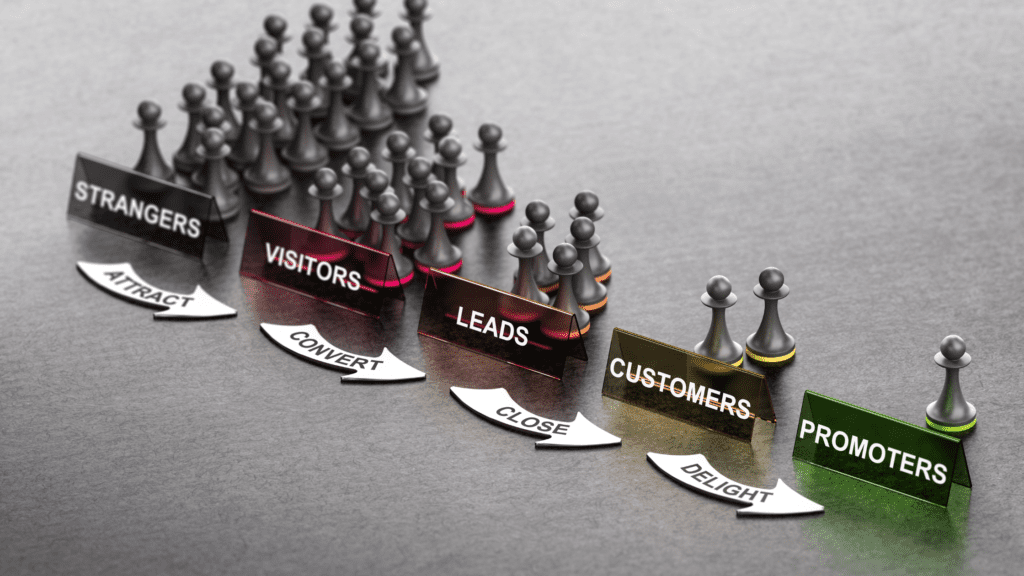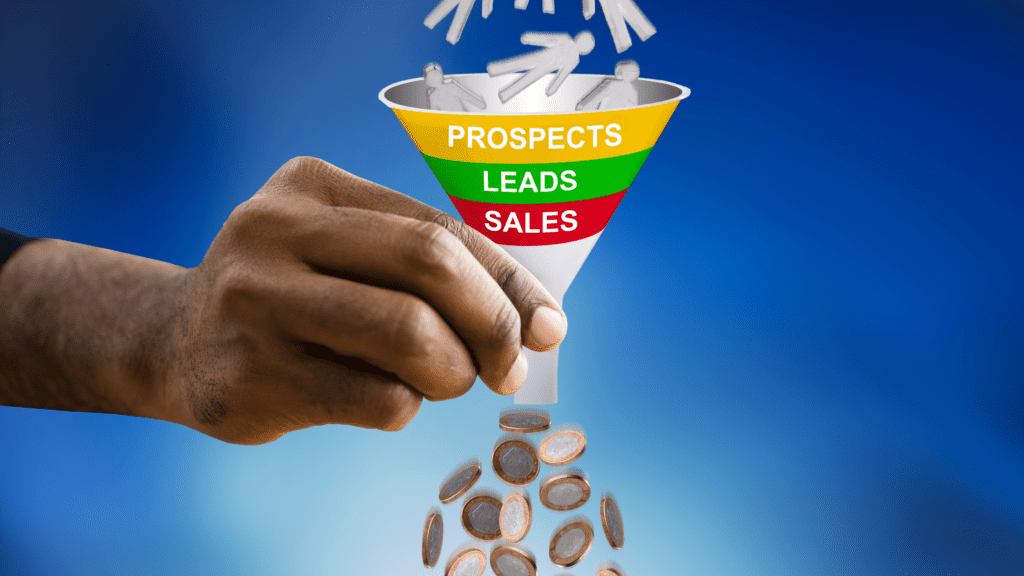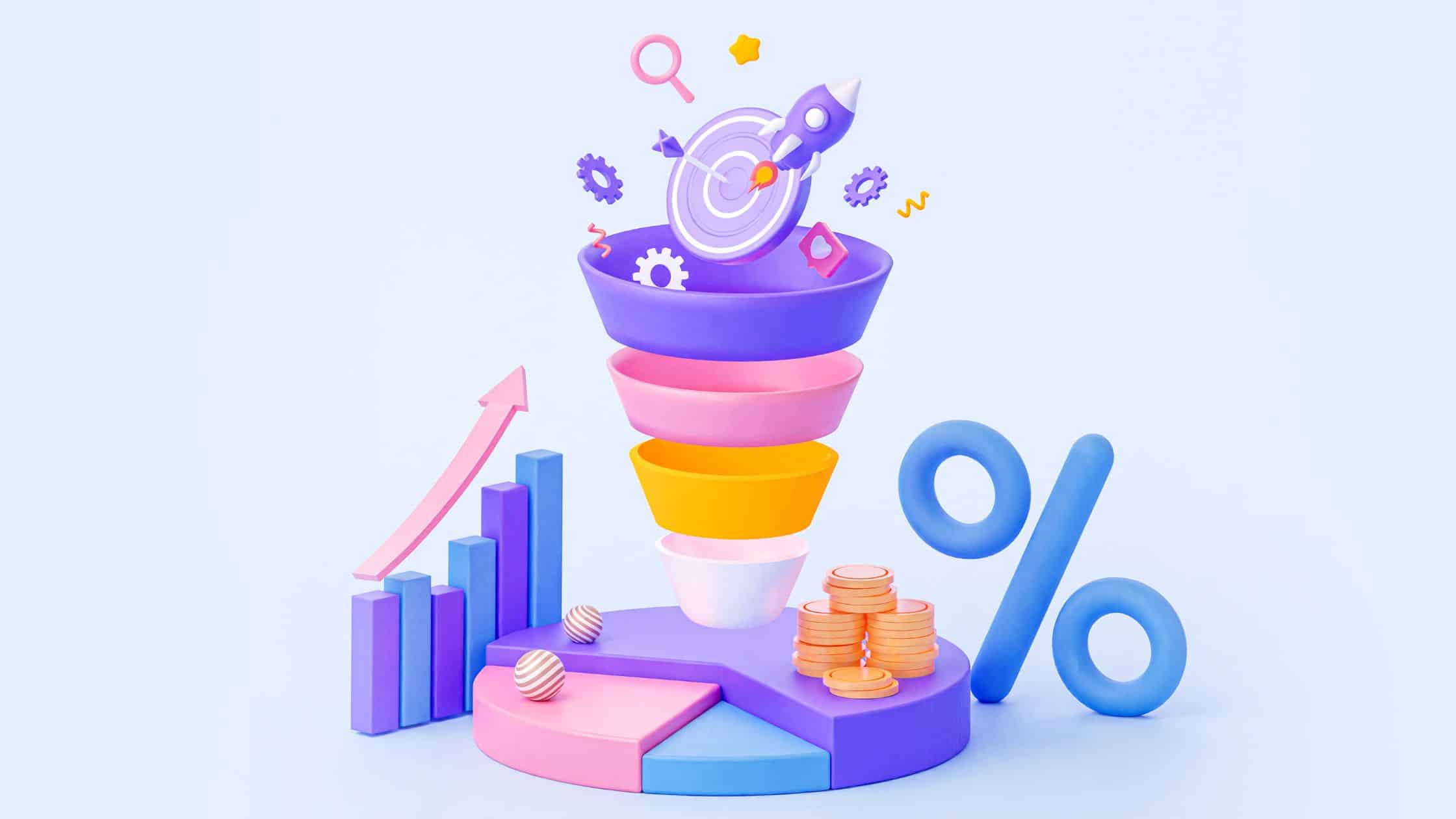The different stages of the sales funnel process impact customer behavior. You need to be familiar with them.
Knowing each step allows you to employ strategies to increase the number of prospects who proceed to the next one.
This could have a positive effect on the bottom line of the company.
Say you doubled the number of people at the second and third steps of the funnel. This doubles the number of leads and the proportion of closed sales. You will receive four times more monthly new customers as a result.
One of the most effective strategies in business is defining and controlling your sales funnel.
Let’s get started.
A Sales Funnel: What Is It?
Each step a person must take to become a customer is represented by a sales funnel.
Let’s examine a traditional sales funnel.
A potential customer walks past your store at the top of the sales funnel. The next stage of the funnel is when a certain proportion of them choose to enter the store.
The person notices a bunch of T-shirts on sale. After browsing through the rack, they have reached the next stage of the funnel. The buyer then proceeds to the checkout after picking 3 t-shirts. This gets them to the last stage. If everything goes as desired, they complete the transaction and get to the end of the funnel.
Every business follows a similar process in one form or another. Your sales funnel and customer journey could consist of:
- physical location
- website
- sales department
- consulting
- email communication
Your sales funnel could include any marketing channel. Additionally, your funnel may span numerous channels.
Are Sales Funnels Effective?
The journey undertaken by your prospects is depicted by the sales funnel.
Understanding the funnel can help you identify the gaps where prospects leave the process without converting.
You can’t optimize your sales funnel and marketing funnel if you don’t understand them. You can help visitors proceed through the funnel and make them convert eventually. We’ll get into more detail about the funnel’s operation below.
How Sales Funnel Works

Despite the fact that there are other phrases used to explain the various stages of a sales funnel, I’ll stick with the four most popular ones. This will describe how each step works as a person moves from being a visitor to a prospect, lead, and then a buyer.
A user finds your website via a social media link or a Google search. Now they are a prospect. The visitor might look through your product listings or a couple of your blog articles. You eventually provide the person with the option to join your email list.
The visitor becomes a lead if they submit your form. Now, you may market to the customer in ways other than using your website, including by phone, text, email, or even all three.
When you contact leads with unique deals, updates on the latest blog articles, or other enticing messaging, they frequently return to your website. You might even provide a promo code.
The sales funnel gets smaller as customers go through it. This is due in part to the fact that there will be more prospects at the beginning than customers at the end of the funnel, but it’s also because your messaging needs to become more targeted.
Sales Funnel: 4 Stages
The abbreviation AIDA, which stands for Awareness, Interest, Decision, and Action, makes it easy to recall the 4 stages of the sales funnel. The mindset of your potential customer may be represented by these stages.
You, the marketer, must take a different approach for each step if you want to communicate the relevant message at the appropriate time. You don’t want to be like a waiter asking about desserts before the customer even placed an order for a drink or an appetizer.
Let’s take a closer look at each step of the sales funnel.
Awareness
This is the point at which a customer first notices you. It could be through a Google search, Facebook post, tweet, or something completely different.
Your prospect learns about your company and what you have to offer.
Sometimes, when the stars align, customers make an immediate purchase. It’s a case of being at the right place, at the right time. The consumer understands that you are providing a desirable product at a fair price since they have already done their homework.
The awareness stage resembles dating in some ways. You’re attempting to entice the prospect to visit your website again and interact with your company more.
Interest
Consumers conduct research, compare prices, and consider their options when they reach the interest stage of the sales funnel. Now is the time to impress them with outstanding content that benefits them without trying to sell anything.
Pushing your products or services from the start will turn off potential customers and drive them away. The idea is to demonstrate your knowledge, assist the customer in making an informed choice, and offer to assist them in any way possible.
Decision
When the customer is prepared to make a purchase, he or she is at the decision stage of the funnel. The person may be considering a few options, hopefully, one of which is you.
Your best offer should be presented at this time. It might be free shipping when the majority of your competitors charge for it, a coupon code, or a complimentary item. In any case, make it so enticing that your lead can’t wait to get a hold of it.
Action
The customer takes action at the end of the sales funnel. He or she makes a purchase from you and is now part of the company’s ecosystem.
But just because a customer completes the funnel doesn’t mean your job is finished. The customer and the marketer should take action. You want to put in every effort to get repeat purchases.
Simply put, customer retention is your main priority. Thank your consumer for their purchase, urge them to provide you with feedback, and, if necessary, offer tech support.
Sales Funnel: Website Example
Imagine that you run an online store where you sell antique items. You are aware that both men and women between the ages of 30 and 65 make up your target market and that they frequently use Facebook.
You manage a Facebook advertisement that sends people to a landing page. On that page, you provide a lead magnet in exchange for a prospect’s email address. Pretty basic, yes?
Instead of prospects, right now you have leads. The funnel is being traversed by them.
You send out content over the coming weeks to inform your subscribers about antique items, give decoration ideas, and help customers in determining how to use these items.
You give each consumer a 5 percent discount on their entire first order at the end of your email blitz. Bang! You’re making a fortune off antique items. Whatever you’re selling is in high demand.
Then you include those subscribers in a newly created email list. You restart the operation, but this time the content is different. Give them examples of collectibles, tips on how to take care of their collections, and suggestions for items to give as gifts. You’re expecting them to return for more.
You now have it:
- Awareness – To direct visitors to your website, you put up a Facebook advertisement.
- Interest – In exchange for lead capture, you provide something of value.
- Decision – Your content educates and sets up your audience to make a purchase.
- Action – To increase retention, create an offer your leads can’t refuse and start marketing to them again.
The Sales Funnel Process

You must be thrilled right now. You would like to quickly develop a sales funnel. Not to worry. It’s not as challenging as you might think.
1. Examine The Behavior Of Your Audience
Your sales funnel in marketing gets more powerful as you understand your audience. You don’t have to market to everyone. You’re targeting customers who will be interested in what you have to offer.
The user behavior reports are useful for tracking website activity and understanding how visitors interact with your website.
What makes them click? At what point do they scroll? How long do people spend on a specific page? You can improve your buyer personas with the use of all of these data elements.
2. Grab The Attention Of Your Audience – Content For Sales Funnel
Your sales funnel is only effective if you can get visitors. This entails getting your content out to your target market.
Post a lot of content on all of your platforms and follow the organic path. Add variety to your content with videos, infographics, and other forms of media.
Run some advertisements if you have the budget for them. Where your target demographic exists will determine the best location to do your advertising. LinkedIn could be the answer if you are promoting B2B products.
3. Create A Landing Page
Your content and ads must lead potential customers to the desired location. The ideal scenario is to send them to a landing page with an irresistible offer.
Focus on acquiring leads rather than trying to close the deal because these customers are still at the early stages of the sales funnel.
A landing page should direct visitors to the call to action.
Whether it’s downloading a free e-book or viewing a how-to video, you need a clear call to action that makes it easy to take to the next step.
4. Start An Email Drip Campaign
By sending useful content to your leads via email, you may market your products and services to them. Do this consistently but not excessively. You only need to send 1 or 2 emails a week.
Prepare your audience for the sale by educating them first. What are they expecting to get from you? What challenges and objections do you have to overcome before they will buy?
Make an irresistible offer towards the end of your drip campaign. That type of content will motivate your leads to take action.
5. Maintain Contact
Don’t overlook your existing clients. Instead, keep in touch with them. Offer them more discount codes, acknowledge their purchases, and invite them to join your social media community.
Sales Funnel: How To Assess The Success
As the company grows, you get a better understanding of your customers. When you increase your offerings, your sales funnel may require adjustments.
Monitoring your conversion rates is a great approach to gauging how well your sales funnel is working.
For instance, how many people join your email list after clicking through a Facebook ad?
Pay close attention to each level of the sales funnel:
- Do your leads trust you enough for them to provide you with their contact details?
- Is your initial content getting noticed by enough customers?
- Do your clients purchase from you again?
- Have your email drip campaign and other marketing initiatives resulted in sales?
Knowing the answers to these points will help you identify the areas of your sales funnel that need adjustment.
Sales Funnel Management Best Practices
The truth is this: There are many options available to your potential clients. Although you want customers to select your services or products, you cannot compel them to do so. You should instead focus on effective marketing.
Without a focused, effective sales funnel, you can only guess what your prospects are looking for. If you’re wrong, the sale is lost.
To see how visitors interact with your website during a session, use heatmap tools. What makes them click? Are they confused by anything? Do they have their attention on the right things?
This is especially crucial for the landing pages we discussed. Most users will simply click away if they are not optimized for conversions.
How To Increase Sales Through Your Funnel
There are several strategies to optimize your sales funnel. The locations where customers move to the subsequent point in the funnel are where you should concentrate your attention the most.
We discussed Facebook ads. Run more than one ad. Even if they may look quite similar, experiment with various buyer personas and use Facebook’s targeting options to make sure your target audience sees those ads.
Run A/B tests on your landing pages. Even though it takes time, you’ll eventually reach more people and more reliably convert prospects.
A/B testing your emails is another aspect to consider. Adapt your wording, offers, visuals, and layouts to see what resonates with your audience.
But paying attention to the performance is the best approach to enhance your sales funnel.
Start at the beginning of the funnel. Whether it’s organic or paid ads, you’re producing content to promote your brand and get people to click through your CTA. Try a different piece of content if the first one doesn’t work.
Next, go to your landing page. Incorporate the CTA and offer into your blog post, Facebook ad, or other assets that help with traffic generation. For the greatest results, test your headline, visuals, body copy, and CTA.
A/B test your offer before asking leads in the Action step to purchase from you. Does free shipping perform better than a discount of 5%? These seemingly insignificant details have a big impact on your bottom line.
Keep an eye on your customer retention rate. Do customers return and make purchases a second, third, or tenth time? Do they recommend it to their friends?
Keep your brand at the forefront of the customer’s mind. Your audience won’t have a reason to go elsewhere if you never let them down.
Conclusion
So do sales funnels really work? It takes time to build and refine a sales funnel. It’s a lot of effort. But in a cutthroat market, it’s the only way to survive.
Surprisingly, a minor issue like font selection can affect conversions. Additionally, you will drive customers away if you ask them to make a purchase too soon.
Spend some time creating a sales funnel that reflects both your goals and those of your target audience. Develop it over time, modify your strategy for various stages of the sales funnel, and determine why your efforts aren’t producing the desired results.
Begin gathering accurate, pertinent information about the users of your website. Raw data cannot be substituted, and you shouldn’t base your sales funnel on the audience and reach of another person. You should make it entirely your own.
